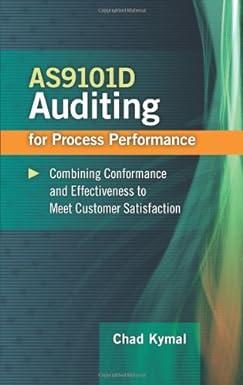Question
Selfridge and Company, Inc. reported the following related to its December 31, 2014 balance sheet: Land, acquired January 1, 2013 $ 80,000 Buildings, acquired January
Selfridge and Company, Inc. reported the following related to its December 31, 2014 balance sheet:
| Land, acquired January 1, 2013 | $ 80,000 |
| Buildings, acquired January 1, 2013 | 200,000 |
| Equipment, acquired January 1, 2013 | 300,000 |
| Trucks, acquired March 1, 2013 | 140,000 |
Buildings are depreciated using a 40 year life, the straight-line method, and no residual value.
Equipment is depreciated using a 7 year life, the sum-of-the-years-digits method, and a residual value of 10% of the equipments initial cost.
Trucks are depreciated using a 5 year life, the double-declining balance method, and a residual value of 20% of the trucks initial cost.
Early in 2015, Selfridge and Company, Inc. purchased a parcel of land with a building for $400,000. The closing statement indicated the land value was $330,000 and the building value was $70,000. In addition, to acquire the land, Selfridge and Company paid a $16,000 commission to a real estate agent and title insurance of $3,000. Shortly after acquisition, the building was demolished at a cost of $21,000. $14,000 was generated from the sale of salvaged materials. Selfridge and Company, Inc. plans to hold this parcel of land for resale.
On April 1, 2015, Selfridge and Company began construction of a new building on land that it has owned since 2013. Architectural plans were formalized on April 1, when the architect was paid $15,000. Excavation work began during the first week in April with payments made to the contractor as follows:
| Date of Payment | Amount of |
| April 30, 2015 | $60,000 |
| October 1, 2015 | 100,000 |
| January 1, 2016 | 150,000 |
Construction was completed on January 31, 2016 and the building was first occupied on that same day.
Selfridge and Company, Inc. had no new borrowings directly associated with the new building but had the following debt outstanding:
10%, 5-year note payable of $1,000,000, dated January 1, 2013, with interest payable annually on January 1. 5%, 10-year bond issue of $1,000,000, sold at par on December 31, 2014, with interest payable annually on December 31.
On January 1, 2016, management became concerned that, due to changes in technology, the equipment may be impaired. Estimated future cash flows associated with the equipment are $150,000 and its estimated fair value is $90,000.
On February 1, 2016, Selfridge and Company, Inc. exchanged its used trucks plus cash of $60,000 for two new trucks. The used trucks had a combined fair market value of $20,000 at the time of the transaction. The exchange lacks commercial substance.
On November 30, 2016, Selfridge and Company, Inc. purchased land with an existing building for $540,000 by making a $200,000 down payment and signing a $340,000 note payable which carries interest at the rate of 8%, payable each November 30. The seller reported that the land and building had book values of $25,000 and $375,000, respectively, prior to the sale. An independent appraisal reported that the fair value of the land and building was $116,000 and $464,000, respectively, at the time of sale. At the point of acquisition, the estimated remaining useful life of the building was 30 years. Immediately after acquisition, the roof on the building was replaced at a cost of $30,000. The cost of the old roof is not known. Selfridge and Company estimates that the replacement of the roof will not increase the useful life of the building or otherwise enhance operational efficiency.
Related to the above:
(a) Prepare the property, plant, and equipment and current liabilities sections of Selfridges balance sheet
for 2015 and 2016. For assets acquired, but not reported as part of PP&E, indicate how they should be
reported in each year.
(b) Provide the income statement effects on an item-by-item basis (e.g. total depreciation expense, total
interest expense, etc.) for Selfridge for 2015 and 2016.
Recommendation: Make all journal entries for 2013-2016 for the items described above. Round all computations to the nearest whole dollar.
Step by Step Solution
There are 3 Steps involved in it
Step: 1

Get Instant Access to Expert-Tailored Solutions
See step-by-step solutions with expert insights and AI powered tools for academic success
Step: 2

Step: 3

Ace Your Homework with AI
Get the answers you need in no time with our AI-driven, step-by-step assistance
Get Started


